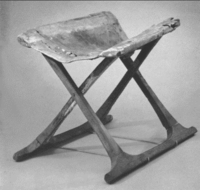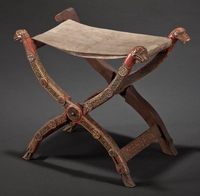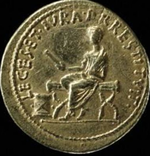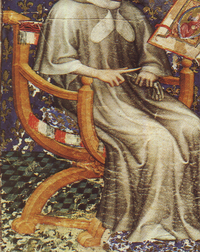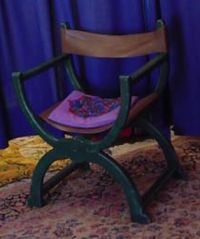Type 1
The Type 1 chair is the X frame chair (or stool). These seats use two connected X frames as the structure and they appear in two forms:
Their method of construction and materials are very similar. Beyond using a pair of connected X frames for the structure, they also share the feature of a flexible seat (and back where there is one). The seat and back can be either leather or textiles and if there is a back, it seems to be made of the same material as the seat.
Type 1A - The Folding Stool
Background:
Type 1A is a simple folding stool. Its structure is two X shaped frames that pivot on the crossover point and are connected by horizontal members. The seat is usually non-rigid and made of textiles or leather.
This form is first recorded in the Middle Kingdom of Egypt (2000-1500 BCE) both as art and extant examples from tomb finds. Based on what's known of early Egyptian culture, they got by with a very limited amount of furniture and were comfortable sitting on the ground in most cases. Therefore, having a seat of any type is a big deal and a clear status symbol even for something as simple as the one depicted to the right. It is only 14" high (modern chairs are 19").
At the left, we have a carved and painted medieval example from the Salzburg, Austria area. Made of pearwood and leather, the seat is about 20” high (the height of modern chairs).
Seating: Both across and along
In ancient times, this form was sat across the X. I've seen conjectures that the reason for this was that the X was a symbol for divinity or power, but I have seen no credible evidence for that assertion.
That said, coins from the Roman Republic show X frame stools sat crosswise, though coins from the Empire, show chairs with a back sat in the expected fashion. Following the civil wars and the rise of the Empire, there was certainly no longer any pretense of divine descent by the Emperors so it's possible that theory has some merit.
In the Middle Ages and later, this form is sat along the X as we’ve come to expect.
Practical Matters: I haven't personally made any stools of this form, only its more complex descendant (see below), but I would rate it "good" on the folding scale for convenient packing/transit since it would pivot until the tops touch. It is particularly suited to camping or field use where a full-size chair isn't necessary.
Common Terms: Fold stool, Faltstuhl (German), Sella Curulis (Latin), Faldistorium (Latin)
Type 1B - The X Frame Chair
Background: There was a lot of variation throughout the ages for the X frame seats. The most significant is the addition of a back. The material of the back is usually the same as the seat: textile or leather.
The adding of a back is accomplished by lengthening the top parts of the X frames. The front X is lengthened to a height to serve as armrests. The back X goes even higher to provide a place to anchor the back. An additional rail is added on each side to support the back and become armrests. The earliest evidence of a backed X chair that I have found (so far) is this 1371 painting shown to the right.
Seating: Along the X
Practical Matters: These chairs are pretty simple and easy to reproduce so they are a common sight in the SCA. What they don't do is fold much. The mechanism will rotate only until the top of the back supports touch each other. So, the taller and more comfortable you make the back, the less useful in folding it becomes. As a result, many historical examples go no higher than the center of the back.
Construction Notes: Orienting the grain of the boards used for the Xs is critical because somewhere along the arc you will have a short-grain area that will be prone to breakage. Looking over the surviving pieces as well as images from period works, you will note that they are all made from quite heavy timber by today's standards to avoid this problem.
I made two sets of these chairs early in my career using two 4' x 8' sheets of maple plywood glued together. This made 1-1/2" stock that was strong enough to support my weight and yet light enough to be easily carried. Even carefully painted, it was hard to hide the plywood nature, but that was the best solution I had at the time.
The only tricky part of this build is the half-lap joint where the Xs cross. You just have to be careful and make sure both the front and back are exactly the same so you don’t add racking stress to the frame.
You could achieve similar and more attractive results by gluing up 3/4 or 4/4" stock with alternate grain orientations, or even just slightly different ones. With modern glues, this would be quite strong without being as heavy as the 4" thick stock the medieval examples show.
Common Terms: Dantesca Chair, X Chair, Dante Chair, Sedia Dantesca (Latin), Scherenstuhl (German)
Still with me? Whew, you're brave. If you'd like to continue this fascinating exploration of medieval folding seats, head to the page on Type 2.
